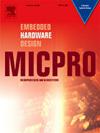A novel machine learning-driven optimization methodology for faster and more efficient design space exploration in high-level synthesis
IF 2.6
4区 计算机科学
Q3 COMPUTER SCIENCE, HARDWARE & ARCHITECTURE
引用次数: 0
Abstract
The optimization of digital circuits is a critical factor in determining the competitiveness of modern electronic systems, particularly in terms of area, performance, and power consumption. High-Level Synthesis (HLS) plays a pivotal role in this optimization process, enabling designers to define system requirements at a higher level of abstraction and providing opportunities to analyze and optimize digital circuits against various metrics prior to production. However, the design constraints inherent in the HLS process often lead to multi-objective optimization problems, which significantly complicate the exploration process. This complexity necessitates the development of novel synthesis methodologies enabling faster and more efficient design space exploration. In response to this need, within the scope of this study, we introduced an innovative and hybrid HLS methodology that combines metaheuristic and machine learning approaches. In this respect, two distinct synthesis tools were developed. The first tool, implemented in C++, utilizes the Simulated Annealing (SA) metaheuristic with a novel three-part solution representation. This representation, a key contribution of our study, aims to minimize the weighted sum of latency and area constraints for Data Flow Graph (DFG) designs. While effective, this approach resulted in extended execution times due to computationally intensive design variables. To address the performance bottleneck identified in the standard cost function evaluation, we developed a second tool that integrates machine learning with the traditional SA. This hybrid approach combines C++ and Python, incorporating a Support Vector Regression (SVR) model to estimate solution costs more efficiently, significantly reducing execution times. Our study also presents the detailed analyses of the experimental results conducted on seven benchmarks with varying node counts. The three-part solution representation in the traditional SA approach demonstrated up to a 53.38% improvement in performance compared to the single-part representation across all benchmarks. For benchmarks with fewer nodes (DiffEq, Lattice, Ellip, and FEWF), the model-based estimation implementation achieved results identical to the traditional approach but required longer execution times. For benchmarks characterized by higher node counts (MatMul, IntAux, and MCM), our novel approach demonstrated equivalent results to the traditional SA implementation with a time savings of up to 129 seconds. We leveraged these time savings to enhance the exploration process, achieving up to 5.4% improvement in solution quality without exceeding the execution time of the traditional approach.
一种新的机器学习驱动的优化方法,用于在高级综合中更快、更有效的设计空间探索
数字电路的优化是决定现代电子系统竞争力的关键因素,特别是在面积、性能和功耗方面。高级综合(HLS)在优化过程中起着关键作用,使设计人员能够在更高的抽象层次上定义系统需求,并提供在生产之前根据各种指标分析和优化数字电路的机会。然而,HLS过程中固有的设计约束往往导致多目标优化问题,这大大复杂化了勘探过程。这种复杂性要求开发新的合成方法,以实现更快、更有效的设计空间探索。为了满足这一需求,在本研究的范围内,我们引入了一种创新的混合HLS方法,该方法结合了元启发式和机器学习方法。在这方面,开发了两种不同的合成工具。第一个工具是用c++实现的,它利用模拟退火(SA)元启发式算法和一种新颖的三部分解表示。这种表示是我们研究的一个关键贡献,旨在最小化数据流图(DFG)设计的延迟和面积约束的加权总和。这种方法虽然有效,但由于计算密集的设计变量,导致执行时间延长。为了解决在标准成本函数评估中发现的性能瓶颈,我们开发了第二种工具,将机器学习与传统SA集成在一起。这种混合方法结合了c++和Python,结合了支持向量回归(SVR)模型来更有效地估计解决方案的成本,大大减少了执行时间。我们的研究还详细分析了在七个具有不同节点计数的基准上进行的实验结果。在所有基准测试中,与单部分表示相比,传统SA方法中的三部分解决方案表示的性能提高了53.38%。对于节点较少的基准测试(DiffEq、Lattice、Ellip和FEWF),基于模型的估计实现获得了与传统方法相同的结果,但需要更长的执行时间。对于具有较高节点计数特征的基准测试(MatMul、inaux和MCM),我们的新方法证明了与传统SA实现相当的结果,并且节省了高达129秒的时间。我们利用这些节省的时间来增强勘探过程,在不超过传统方法执行时间的情况下,将解决方案质量提高了5.4%。
本文章由计算机程序翻译,如有差异,请以英文原文为准。
求助全文
约1分钟内获得全文
求助全文
来源期刊

Microprocessors and Microsystems
工程技术-工程:电子与电气
CiteScore
6.90
自引率
3.80%
发文量
204
审稿时长
172 days
期刊介绍:
Microprocessors and Microsystems: Embedded Hardware Design (MICPRO) is a journal covering all design and architectural aspects related to embedded systems hardware. This includes different embedded system hardware platforms ranging from custom hardware via reconfigurable systems and application specific processors to general purpose embedded processors. Special emphasis is put on novel complex embedded architectures, such as systems on chip (SoC), systems on a programmable/reconfigurable chip (SoPC) and multi-processor systems on a chip (MPSoC), as well as, their memory and communication methods and structures, such as network-on-chip (NoC).
Design automation of such systems including methodologies, techniques, flows and tools for their design, as well as, novel designs of hardware components fall within the scope of this journal. Novel cyber-physical applications that use embedded systems are also central in this journal. While software is not in the main focus of this journal, methods of hardware/software co-design, as well as, application restructuring and mapping to embedded hardware platforms, that consider interplay between software and hardware components with emphasis on hardware, are also in the journal scope.
 求助内容:
求助内容: 应助结果提醒方式:
应助结果提醒方式:


